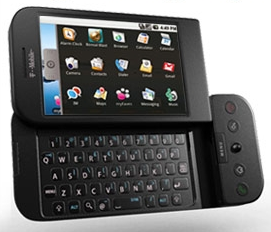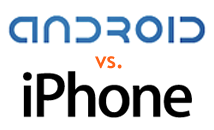
By now, all the first full reviews of the Android G1 phone have come out. This isn’t one of them. You can read CrunchGear’s in-depth review or my initial impressions of the G1 in an earlier post. And there are plenty of other places where you can (re)read about the specs, the slide-out keyboard, and the $179 price.
But I did get my Android loaner from T-Mobile last Friday and have been carrying it around constantly, reading my e-mails on the subway, surfing the Web, and playing with the Google Maps Street View compass feature—when New York City isn’t blocking my GPS. I can’t put it down.
That is not to say that I have set aside my iPhone. In fact, I still carry that around in my pocket as well, right next to the G1. (Yes, I know it’s weird). After living with both side by side for a few days, my initial impression has deepened that the G1 is no iPhone. But I’m also convinced that it doesn’t really matter. The Android is going to be a runaway success once it goes on sale October 22. (Already, 1.5 million are rumored to be pre-sold. Update: That estimate might be inflated, but T-Mobile did sell out of its initial pre-order allotment). The Android and the iPhone together stand in a class by themselves. As I noted in my initial take:
. . .in the end this is not really about Android versus the iPhone. It’s about Web phones versus the brick in your pocket. Simply matching the iPhone on many of these features—especially Web browsing and email—is going to be enough to help redefine the mobile market. The table stakes have just been raised. From now on, phones need to be nearly as capable as computers. All others need not apply.
I still believe that, and the apps on Android have a real chance of blowing away the apps on the iPhone some day just because Android is much more open. It lets developers access pretty much anything on the phone, from the camera to the music library (both of which are currently restricted zones on the iPhone). But that is a post for another day. Right now, I’m going to focus on how the Android stacks up to the iPhone in its most elemental features.
 How do they compare? Both the Android and the iPhone are very similar in their basic capabilities. They both have large touchscreens, GPS, WiFi, 3G cellular antennas, accelerometers, and a camera. On the software side, the both have fully capable browsers (based on Webkit), Gmail, GPS-enabled Google Maps, a music player, and a whole array of third-party apps that you can browse and download directly from an App Store on each device (Google calls its store an App Market).
How do they compare? Both the Android and the iPhone are very similar in their basic capabilities. They both have large touchscreens, GPS, WiFi, 3G cellular antennas, accelerometers, and a camera. On the software side, the both have fully capable browsers (based on Webkit), Gmail, GPS-enabled Google Maps, a music player, and a whole array of third-party apps that you can browse and download directly from an App Store on each device (Google calls its store an App Market).
So far, so good. Where things break down with the G1 is in subtle differences in the user interface that keep making me stumble and pause to try to figure out what to do next. This is a problem I rarely have with the iPhone. The crux of the problem is that the G1 has too many buttons. There is, I’m afraid, a hardware/software disconnect. Too often on the G1, the hardware gets in the way.
This disconnect stems from one of the G1’s standout features that distinguishes it from the iPhone: the slide-out keyboard and the dedicated buttons below the touchscreen. The keyboard in particular is supposed to be one of the G1’s great selling points. After all, people like pressing buttons, especially when they are typing. But the keyboard actually turns out to be superfluous.
As a former Crackberry addict, I never thought I’d say this. But once you get used to typing on a touchscreen, it turns out to be easier and faster than typing on a tiny keyboard. It takes a while to realize this, but once you do there is no going back.
Maybe I’ve just been brainwashed by my iPhone, but I find its touchscreen keyboard to be much simpler to use. The individual keys are much bigger, especially since they expand as you get closer to each one. I do miss the tactile feedback, but that is replaced by an almost equally satisfying clicking sound when you press each key. And the predictive spelling takes care of most mistakes.
Instead of offering up a keyboard whenever you need it, the G1 forces you to switch modes whenever you want to type. That involves flipping open the screen to reveal the keyboard below. The layout of the keyboard itself takes a little getting used to. It looks like standard QWERTY keyboard, except that there is an additional “menu” button where the shift button should be. The shift button us below it. But to type secondary symbols like question marks and dollar signs, instead of hitting the shift button you need to hit an “ALT” button. I am constantly hitting the “menu” button out of habit.
Once you finally type out an email, you cannot send it using the keyboard. Rather, you have to hit the menu button, which brings up a “send” option.” The G1 forces you to switch back and forth between hardware and touchscreen inputs all the time. It is annoying and jarring.
This also happens when the keyboard is closed and you are happily browsing the Web, reading through e-mails, or playing with one of the apps. It’s all touchscreen happiness, until inevitably you hit a wall and have to resort to the hard menu button or the dedicated “back” button below the screen. If all else fails, there is the handy “home” button that takes you back to the Android mobile desktop.
Maybe it’s just me, but when I’m in flying in touchscreen mode, I want to stay in touchscreen mode. What is amazing about both the Android and the iPhone is that they are truly immersive experiences. Don’t bring be back to reality by making me hunt and peck for a hard key.
Another flaw of the Android is that the only way to switch the screen to a horizontal landscape mode is to flip open the keyboard. With the iPhone, you just turn the phone on its side. Android should have copied this because sometimes you want to go horizontal when you are simply browsing the Web. It’s easier to read a Webpage that way. I find myself flipping open the keyboard just to browse the Web, but I’m not typing so the keyboard gets in my way, again. I do like the little roller ball, though. They should keep that. It’s great for playing Pac-Man.
Other pet peeves: Apple’s browser is also a little bit more satisfying. Android resizes everything into annoyingly long columns when you make anything big enough to read. And the iPhone’s screen is a tad sharper, which makes a difference when you are reading tiny print or watching videos.
Android does do some things better than the iPhone. Android has an advantage on pretty much anything that has to do with Google apps. For instance, conversations in Gmail are threaded together. On the iPhone for some reason each response is shown as a separate e-mail, and the default is set to downloading 50e-mails at a time. With Android, you get a lot more. You can also sync easier with your Google data, download all your contacts from Gmail, and Gtalk works like a charm.
Google Maps on Android includes Street View pictures. Coupled with the compass and GPS, you can see a picture of the street you are on or the building in front of you simply by holding up the phone and moving it around. I could easily see Google adding in layers of data, in effect tagging the real world Tonchidot-style.
There’s so much Android could be, and remember, this is just the first phone. But in order for it to have a chance at surpassing the iPhone and becoming the de facto mobile computing platform, it needs to close the gap on its user interface issues. The interface needs to be flawless. Invisible yet always available. For Android, that may be a dream, but it is one that is within reach.